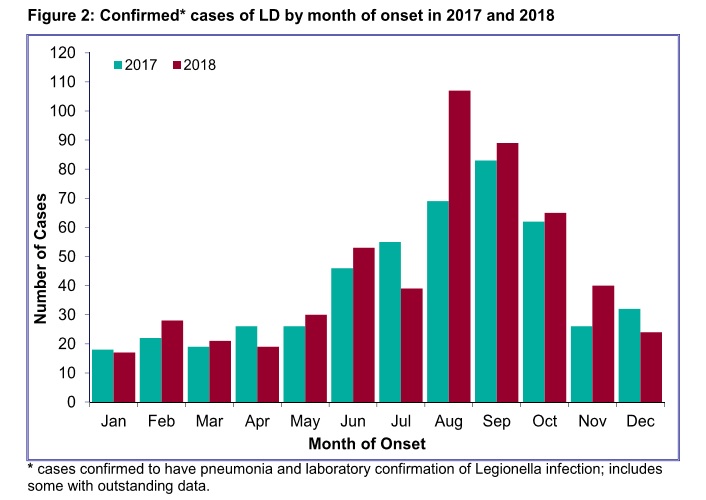Public Health England regularly releases statistics on the number of cases of Legionnaires’ disease in England and Wales. The graph above is from the 2018 statistics covering both 2017 and 2018, it clearly shows a seasonal pattern of Legionnaires’ disease.
This seasonality in England and Wales shows a similar pattern year on year, with June to October being the peak months. Previously the PHE have said this seasonality is due to meteorological factors but what does this mean?
A 2016 Latvian paper (Influence of sampling season and sampling protocol on detection of Legionella contamination in hot water. Pule et al, 2016) concluded that:
“Our results showed significantly higher (p< 0.05) occurrence of L. pneumophila in summer. This is in accordance with the results of other studies, which found a peak in L. pneumophila contamination during the summer (Blanky, 2015), and have supported the opinion that conditions in water supply systems are not constant…”
So the phenomenon is not limited to England and Wales, seasonality exists in many countries with the above paper suggesting it is due to water supply systems are not constant.
What could cause these effects? One obvious cause is the variation in water temperature in the cold water storage system throughout the year. There have been several papers describing this effect, for example “Present-day monitoring underestimates the risk of exposure to pathogenic bacteria from cold water storage tanks. Peter and Routledge. 2017” which demonstrated this phenomenon was compounded when stagnation also occurs.
Another cause is weather patterns, particularly wet, warm, and humid weather, as described in “Weather-Dependent Risk for Legionnaires’ Disease, United States. Simmering et al, 2017”. This will allow Legionella bacteria to survive in aerosols and to be transmitted further distances once released from their source, such as a cooling tower.
The European Technical Guidelines for the prevention, control and investigation of infections caused by Legionella species, 2017, also described risk factors as including seasonality of holiday venues which can lead to a risk of stagnation and biofilms that support Legionella growth…holiday makers are more likely to use spa pools and swimming pools with water features and to visit warmer climates where cold water temperatures exceed 20oC.
The balance of opinions appears to be that warmer temperatures found in the summer months encourage the proliferation of Legionella bacteria which is then exacerbated by water stagnation and a lack of guidance in some countries to keep water systems clean.
If you would like help and guidance on how to minimise the risk of Legionella bacteria on your site then contact Collaton Consultancy Limited on general@collatonconsultancy.com. We offer training, advice and technical support on how to keep your systems clean.



Great post 😁
LikeLike
Thank you for your report. In the United States I notice a rise in numbers during July (when I was struck down) and August, the 2 hottest months of the year. I wish more could be done to learn more about this life-threatening illness!
LikeLike